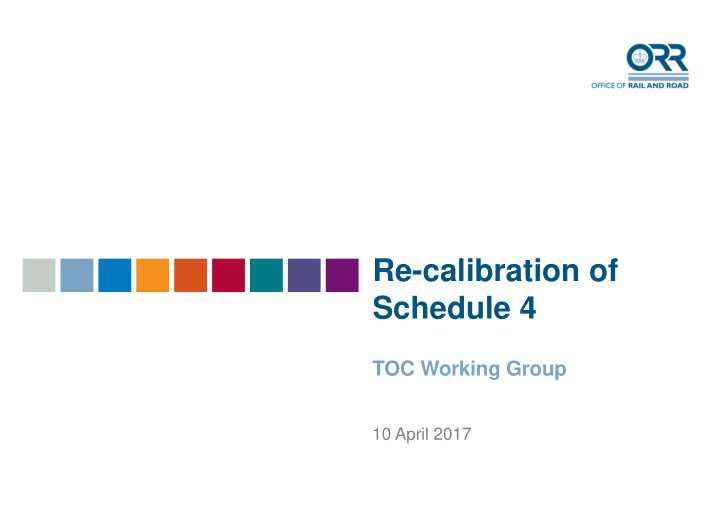



Re-calibration of Schedule 4 TOC Working Group 10 April 2017
2 Purpose of these sessions • To agree the detailed scope of the recalibration work by June to enable industry deliver the work needed • The focus is on re-calibration not policy i.e. its about the specific numbers in the formula and detailed methodology rather than reviewing principals or fundamental aspects of the methodology. Issue to discuss When Bus replacement costs 10 April 2017 Train mileage costs 10 April 2017 Contractual wording Initial discussion on 10 April ACS methodology May meeting SPD and bespoke compensation thresholds May meeting Notification Discount Factors May meeting
3 Cost compensation
4 Cost compensation Rail Cost Train mileage = + replacement compensation costs bus costs Calculated based on: Calculated based on - The change in train miles - Estimated bus miles - Cost per train mile - Payment rate - The basis for these calculations is the analysis carried out as part of PR08 - However they were updated during PR13: - EBM rates adjusted to bring compensation paid in line with actual costs - TMC rates uprated by inflation
5 Rail bus replacement costs
6 Current methodology Estimated bus Estimated bus miles Rail replacement x = miles (EBM) payment rate (EBMPR) bus costs (RRBC) For full route replacement: For partial replacement: Fixed rates - currently two rates EBM = Weighting x EMB = 0.5 x miles x one for LSE xxxxxx miles xxxxxx ITS (£14.29*) and one for the rest of the Weighting varies by ITS being linked to country (£9.66*) segment of route stops at intermediate stations * In 2012/13 prices
7 What is the basis for this approach? ■ Formulaic cost compensation introduced as part of a fundamental review of Schedule 4 as part of PR08 ■ Analysis of TOC data found replacement bus costs accounted for the majority of TOCs’ possession costs (c 90%+) ■ This analysis also confirmed that none of the simple measures of disruption (number of possessions, length of possessions etc) provided an adequate basis for calculating compensation ■ Concept of estimated bus miles (EBM) was established as an alternative: – Data was collected from 5 TOCs who agreed to participate (data was for all replacement bus costs not the cost of one bus – reflecting the fact that one cancelled train may need multiple replacement buses) – Statistical analysis shows that there was a reasonable linear relationship between EBM and replacement bus costs (more so than the alternatives put forward) ■ Pre-established lookup values used to calculate bus cost compensation to allow TOCs to plan/budget possession costs compensation according to agreed, predictable and calculable rules.
8 Example EBM lookup values
9 Example replacement bus cost compensation calculation Total Compensation: = £4,648
10 Options for re-calibration Option 1: Do minimum (Base case) - Uplift current rates inline with inflation Option 2 : Update the payment rates only - Use cost data to review and assess the existing payment rates – any changes would need to be supported by evidence; - Consider whether the two rates are sufficient (eg is a separate intercity rate needed) Option 3: Update payment rates and review weightings - As per option 1 but also review and assess the appropriateness of the weightings used for full service replacements Option 4: Review methodology - Fundamental review of the methodology underpinning the calculation of bus replacement costs
11 Discussion of options for re-calibration Three possible areas for recalibration (covered in options 2-4): • Payment rates • Weightings • Methodology The key issue is what recalibration of these would deliver compared to the work involved – as opposed to simply adjusting rates for inflation (option 1). Questions for discussion: - Is there any evidence that bus rates have changed significantly since PR13 (compared to RPI)? - Is there any evidence of issues with the weightings? - Is there any evidence that the underlying methodology is no longer fit for purpose? (eg is there any evidence that the linear relationship between EBM and replacement bus costs has changed?
12 Train mileage costs
13 Current methodology Train mileage Change in Payment rate x = costs (TMC) miles (TM) per train mile (TMPR) Basis for this approach - Intended to take into account the savings made (or costs incurred) by not running (or diverting) services - Intended to reflect the variable access charges paid by each TOC and fuel costs - Does not include changes in the staff or maintenance costs as a result of possessions
14 Options for recalibration Option 1: Uplift payment rate inline with inflation (Base case) Option 2: Review payment rate in light of changes to variable costs including VUC, fuel costs. Including considering whether other variable costs should be included. Our initial thoughts: • During PR13 rates were simply increased in line with inflation • It may therefore be appropriate to review the rates more fully in PR18 • Option 2 should be manageable within the timeframes and deliver a more accurate incentives/compensation level
15 Contractual wording
16 Issues with contractual wording • Various people have raised different issues with the existing contractual wording • It would be helpful if we could have a common log of known issues • This would then allow us to consider possible fixes Ref Specific Brief summary Raised by Detailed description of the issue Possible solutions paragraph reference Example Schedule 4 Bus - Train Payments: it is GWR It might mean the train unit finishes Amend the definition Part 3 unclear what is meant by and then another train is used from of TTSSG ‘terminating at a destination paragraph the next station, because the 3.6 other than that shown for journey and destinations are still those Trains’ reached in order to have a WACM of 0 - We will circulate a template (populated with issues we are already aware of) – can parties please populate this by the end of April - We can then discuss the issues at our May or June WG
Recommend
More recommend